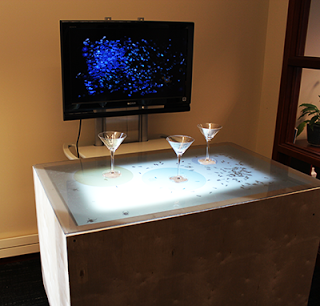 |
| godbox by Chris Thompson |
- Can algorithms be art?
- How have recent discoveries in
neurology changed our concept of freewill? - Can the vernacular of video games
and data-visualization be used as an artistic medium? - What is the difference between an
artwork and a scientific experiment?
godbox
On display in the Champlain College Library, godbox, a hybrid artwork-scientific
experiment examines how recent discoveries in neurology are changing our
notion of free will. It uses software
algorithms to evoke involuntary reactions in viewers by stimulating three
distinct levels of cognitive perception. The artificial swarming flies ability
to cause a sense of revulsion, relies on subconscious pattern recognition
processes occurring in the reptilian portion of the brain. Likewise, when patterns of social interaction
between flies emerge from the complexity activity occurring on the table—
groupings, attraction, sex, birth, death—our limbic system’s obsession with
social behavior is stimulated. Finally,
if individual flies appear to exhibit unusual behavior, venture beyond their
environment and encounter and overcome obstacles it could be our cerebral cortex’s desire to
organize patterns of behavior into structured narratives.
experiment examines how recent discoveries in neurology are changing our
notion of free will. It uses software
algorithms to evoke involuntary reactions in viewers by stimulating three
distinct levels of cognitive perception. The artificial swarming flies ability
to cause a sense of revulsion, relies on subconscious pattern recognition
processes occurring in the reptilian portion of the brain. Likewise, when patterns of social interaction
between flies emerge from the complexity activity occurring on the table—
groupings, attraction, sex, birth, death—our limbic system’s obsession with
social behavior is stimulated. Finally,
if individual flies appear to exhibit unusual behavior, venture beyond their
environment and encounter and overcome obstacles it could be our cerebral cortex’s desire to
organize patterns of behavior into structured narratives.
Employing
artificial intelligence algorithms, and complex systems theory, godbox, probes the “hyperactive pattern
recognition machine” that is the human mind. Like the evolutionary neurology
research that inspired it, godbox
challenges fundamental beliefs including our notions of love, religion, culture
and individuality.
artificial intelligence algorithms, and complex systems theory, godbox, probes the “hyperactive pattern
recognition machine” that is the human mind. Like the evolutionary neurology
research that inspired it, godbox
challenges fundamental beliefs including our notions of love, religion, culture
and individuality.
The
Technology
godbox is a custom hardware and
software simulation written in the Java based, Processing programming
framework, using ReactiVision’s multi-touch, fiducial object recognition
software libraries. It is based upon the
same technology as Microsoft’s $10,000 Surface touch table, but much, much
cheaper. It employs infrared led light sources and a hacked PS2 camera to
capture reflections of objects on the table surface invisible to the human eye,
through a technique known as Frustrated Total Internal Reflection (FTIR).
software simulation written in the Java based, Processing programming
framework, using ReactiVision’s multi-touch, fiducial object recognition
software libraries. It is based upon the
same technology as Microsoft’s $10,000 Surface touch table, but much, much
cheaper. It employs infrared led light sources and a hacked PS2 camera to
capture reflections of objects on the table surface invisible to the human eye,
through a technique known as Frustrated Total Internal Reflection (FTIR).
About the artist
Christopher
Thompson is a second
year graduate student in Champlain College’s Emergent Media MFA program.
Previously he was curator of Burlington’s BCA Contemporary Art Center. Prior to
that he served as Chief Technology Officer at Gardener Supply Corp and Advanced
Technology Director at Jager Di Paola Kemp Design.
Thompson is a second
year graduate student in Champlain College’s Emergent Media MFA program.
Previously he was curator of Burlington’s BCA Contemporary Art Center. Prior to
that he served as Chief Technology Officer at Gardener Supply Corp and Advanced
Technology Director at Jager Di Paola Kemp Design.
Thanks
Special thanks to the Core Division and the Champlain College Library for sponsoring this exhibit.

